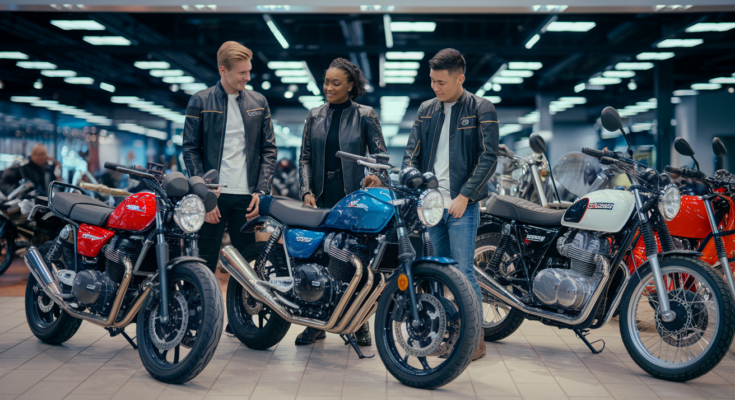Are you dreaming of the perfect starter bike but feeling overwhelmed by the options? Choosing your first motorcycle can be exhilarating and daunting at the same time. With so many models, styles, and features to consider, it’s easy to get lost in a sea of choices. But fear not! Whether you’re drawn to the sleek lines of a sportbike, the rugged charm of an adventure bike, or the laid-back appeal of a cruiser, there’s a perfect ride out there for you—and it doesn’t have to break the bank.
Imagine cruising down open roads, feeling the wind on your face, and experiencing the thrill of two-wheeled freedom—all without emptying your wallet. That’s the promise of finding the ideal starter bike under $5,000. But how do you navigate the market to find that sweet spot between performance, safety, and affordability? 🏍️💨
In this comprehensive guide, we’ll walk you through the essential steps to choose your dream starter bike. From determining your riding style to evaluating engine sizes, and from exploring different bike categories to comparing popular models, we’ve got you covered. We’ll even delve into the pros and cons of buying used versus new, and highlight the safety features you shouldn’t compromise on. So, gear up and get ready to embark on your journey to motorcycle mastery—your perfect starter bike awaits!
Determine Your Riding Style and Needs
A. Consider your intended use
When selecting a starter bike under $5K, it’s crucial to determine the primary purpose. Consider these options:
| Riding Style | Suitable Bike Types |
|---|---|
| Commuting | Naked, Commuters |
| Sport | Sportbikes |
| Touring | Adventure, Touring |
| Off-road | Dual Sports, Enduro |
B. Assess your skill level and experience
Beginners should opt for bikes with manageable power and user-friendly features. Naked bikes like the Kawasaki Z400 ABS offer smooth rides and comfortable designs. Cruisers such as the Honda Rebel 500 provide low seat heights and forgiving power delivery. With this in mind, next, we’ll explore how to set a realistic budget for your starter bike.
Set a Realistic Budget
Now that we’ve determined the riding style and needs, it’s crucial to set a realistic budget for the perfect starter bike under $5,000. This budget should account for more than just the motorcycle itself.
Factor in the cost of protective gear
- Helmet: $200-$500
- Jacket: $100-$300
- Gloves: $50-$150
- Boots: $100-$300
Consider insurance expenses
| Type of Coverage | Estimated Annual Cost |
|---|---|
| Liability Only | $100-$300 |
| Comprehensive | $300-$700 |
Plan for potential maintenance and repairs
- Regular oil changes: $50-$100
- Tire replacements: $200-$400
- Annual service: $200-$500
With this budget breakdown in mind, the next step is to choose the right engine size for your needs and skill level.
Choose the Right Engine Size
A. Understand the benefits of smaller displacement engines for beginners
Now that we’ve set a realistic budget, it’s crucial to choose the right engine size. Smaller displacement engines offer numerous advantages for novice riders. They provide manageable power, allowing beginners to learn essential skills with less risk. Typically ranging from 250cc to 400cc, these engines offer a balance of performance and control.
B. Consider parallel twin and single-cylinder engines for predictable performance
| Engine Type | Benefits |
|---|---|
| Single-cylinder | Economical, simple |
| Parallel twin | Versatile, balanced |
Single-cylinder and parallel twin engines are excellent choices for starters. Single-cylinder engines are economical and straightforward, while parallel twins offer versatility and balanced performance. These configurations provide predictable power delivery, enhancing the learning experience. With engine size sorted, the next step is to evaluate bike weight and ergonomics for optimal comfort and control.
Evaluate Bike Weight and Ergonomics
Now that we’ve covered engine size, let’s focus on the bike’s physical characteristics. Evaluating weight and ergonomics is crucial for a comfortable and safe riding experience.
Look for lightweight options for easier handling
Lightweight motorcycles offer better maneuverability, especially for beginners. Consider models like:
| Model | Weight | Benefit |
|---|---|---|
| Honda GROM | Light | Easy to handle |
| KTM 390 Adventure | Lightweight | Off-road capable |
| Yamaha YZF-R3 | Balanced | Sporty handling |
Consider seat height and bike width
Proper fit is essential for control and comfort. Key factors include:
- Seat height (should allow feet to touch the ground)
- Handlebar reach
- Overall bike width
Test different bike types for comfort
Explore various styles to find the best ergonomic fit:
- Cruisers (e.g., Honda Rebel series)
- Sport bikes (e.g., Yamaha YZF-R3)
- Standards (e.g., Suzuki SV650)
With these ergonomic considerations in mind, next we’ll explore different bike categories to further narrow down your options.
Explore Different Bike Categories
Now that we’ve evaluated bike weight and ergonomics, let’s explore different bike categories suitable for beginners. Each category offers unique characteristics to match various riding styles and preferences.
Sport bikes: Performance-oriented with aggressive riding position
Cruisers: Comfortable for long rides with lower seat heights
Adventure bikes: Versatile for both on and off-road use
Standard/Naked bikes: All-round performers with upright riding position
| Category | Key Features | Example Models |
|---|---|---|
| Sport bikes | Aggressive posture, high performance | Yamaha YZF-R3, Honda CBR500R |
| Cruisers | Low seat height, relaxed riding | Honda Rebel series, Indian Scout Bobber Sixty |
| Adventure bikes | Versatile, off-road capable | KTM 390 Adventure, BMW G310 GS |
| Standard/Naked bikes | Upright position, balanced performance | Honda CB500F, Suzuki SV650 |
With these categories in mind, we’ll next compare popular starter bike models to help you make an informed decision.
Compare Popular Starter Bike Models
Now that we’ve explored different bike categories, let’s compare popular starter bike models under $5,000. These models offer a range of options for new riders across various styles and preferences.
A. Kawasaki Ninja 400: Balanced sport bike for beginners
The Kawasaki Ninja 400 is a top choice for beginners seeking a sport bike experience. Priced at $4,999, it features:
- 399cc engine producing 49hp
- Top speed of 116.7 mph
- User-friendly power delivery
- Suitable for taller riders
B. Honda Rebel 300: Accessible cruiser with low seat height
The Honda Rebel 300, priced at $4,749, offers:
- Cruiser styling
- Smooth handling
- Low seat height for easy maneuverability
- Appealing to various skill levels
C. Yamaha MT-03: Versatile naked bike for urban riding
The Yamaha MT-03, at $4,999, provides:
| Feature | Description |
|---|---|
| Engine | 321cc |
| Style | Naked bike |
| Use | Urban riding |
| Handling | Agile |
D. Suzuki Boulevard 800: Reliable cruiser with smooth performance
The Suzuki Boulevard 800 offers:
- Smooth performance
- Reliability
- Comfortable cruising experience
- Models from 2005 to 2013 available under $5,000
With these popular models in mind, next we’ll consider the pros and cons of buying used versus new motorcycles.
Consider Buying Used vs. New
Advantages of purchasing a pre-owned motorcycle
After comparing popular starter bike models, it’s crucial to consider the benefits of buying used versus new. Pre-owned motorcycles offer significant cost savings due to depreciation, potentially allowing riders to acquire higher-end models within their budget. Used bikes may also have lower insurance premiums and repair costs, making them an attractive option for budget-conscious beginners.
How to inspect and evaluate a used bike
| Inspection Checklist |
|---|
| Check maintenance history |
| Examine wear and tear |
| Verify mileage |
| Assess modifications |
| Consider potential repair costs |
Benefits of warranty and latest features with new bikes
New motorcycles come with advantages such as:
- Factory warranties
- Modern safety features (e.g., ABS)
- Advanced technology
- Minimal maintenance requirements
When prioritizing safety features in the next section, these aspects of new bikes will be particularly relevant.
Prioritize Safety Features
Now that we’ve explored the pros and cons of buying used versus new motorcycles, it’s crucial to prioritize safety features when choosing a starter bike. Safety should be a top concern for all riders, especially beginners.
Look for bikes with ABS (Anti-lock Braking System)
ABS is a vital safety feature that prevents wheel lock-up during sudden braking, reducing the risk of skidding. It’s now standard on motorcycles above 125cc, making it easier for new riders to find bikes equipped with this technology.
Consider models with traction control
Traction control enhances stability on slippery surfaces by adjusting to road conditions. This feature is particularly beneficial for inexperienced riders who may encounter challenging terrain or weather conditions.
Evaluate braking systems (disc vs. drum brakes)
| Brake Type | Advantages | Considerations |
|---|---|---|
| Disc Brakes | Better stopping power, improved heat dissipation | More common on modern bikes |
| Drum Brakes | Simpler design, lower maintenance | Less effective in wet conditions |
With these safety features in mind, the next step is to test ride before buying to ensure the chosen bike feels comfortable and manageable.
Test Ride Before Buying
Now that we’ve covered the importance of prioritizing safety features, it’s crucial to test ride before making a final decision. This step allows potential buyers to assess comfort, handling, and overall fit firsthand.
Schedule test rides with local dealerships
Local dealerships often offer test ride opportunities. Contact multiple dealers to compare different models and brands. Create a schedule to test various bikes, ensuring a comprehensive evaluation.
Pay attention to comfort, handling, and fit
| Aspect | What to Consider |
|---|---|
| Comfort | Seat cushioning, riding position |
| Handling | Maneuverability, braking response |
| Fit | Reach to controls, foot placement |
Trust your instincts and personal preferences
After test riding, reflect on the experience. Consider which bike felt most natural and aligned with riding goals. Remember, personal comfort and confidence are paramount when choosing a starter motorcycle.
Choosing the perfect starter bike under $5,000 requires careful consideration of various factors. From determining your riding style and needs to setting a realistic budget, selecting the right engine size, and evaluating bike weight and ergonomics, each aspect plays a crucial role in finding the ideal motorcycle. Exploring different bike categories, comparing popular starter models, and weighing the pros and cons of buying used versus new are essential steps in the decision-making process.
Ultimately, prioritizing safety features and taking the time to test ride potential bikes are paramount. By following these guidelines and trusting your instincts, you can confidently select a motorcycle that not only fits your budget but also aligns with your riding goals and preferences. Remember, the perfect starter bike is one that inspires confidence, comfort, and excitement as you embark on your motorcycling journey.




